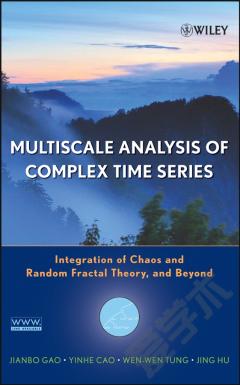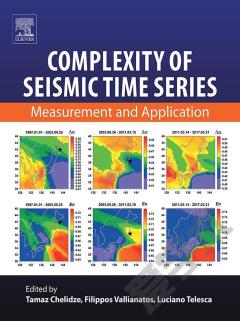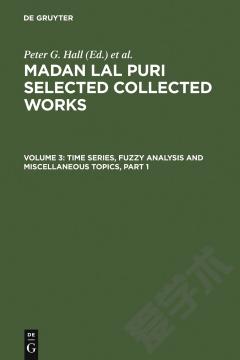Multiscale Analysis of Complex Time Series —— Integration of Chaos and Random Fractal Theory, and Beyond
----- 随机分形信号处理
Preface. 1. Introduction. 1.1 Examples of multiscale phenomena. 1.2 Examples of challenging problems to be pursued. 1.3 Outline of the book. 1.4 Bibliographic notes. 2. Overview of fractal and chaos theory. 2.1 Prelude to fractal geometry. 2.2 Prelude to chaos theory. 2.3 Further reading and bibliographic notes. 2.4 Warming up exercises. 3. Basics of probability theory and stochastic processes. 3.1 Basic elements of probability theory. 3.1.1 Probability system. 3.1.2 Random variables. 3.1.3 Expectation. 3.1.4 Characteristic function, moment generating function, Laplace. transform, and probability generating function. 3.2 Commonly used distributions. 3.3 Stochastic processes. 3.3.1 Basic definitions. 3.3.2 Markov processes. 3.4 Special topic: How to find relevant information for a new field quickly?. 3.5 Bibliographic notes. 3.6 Exercises. 4. Fourier analysis and wavelet multiresolution analysis. 4.1 Fourier analysis. 4.1.1 Continuous-time signals. 4.1.2 Discrete-time signals. 4.1.3 Sampling theorem. 4.1.4 Discrete Fourier transform. 4.1.5 Fourier analysis of real data. 4.2 Wavelet multiresolution analysis. 4.3 Bibliographic notes. 4.4 Exercises. 5. Basics of fractal geometry. 5.1 The notion of dimension. 5.2 Geometrical fractals. 5.2.1 Cantor sets. 5.2.2 Von Koch curves. 5.3 Power-law and perception of self-similarity. 5.4 Bibliographical notes. 5.5 Exercises. 6. Self-similar stochastic processes. 6.1 General definition. 6.2 Brownian motion (Bm). 6.3 Fractional Brownian motion (fBm). 6.4 Dimensions of Bm and fBm processes. 6.5 Wavelet representation of fBm processes. 6.6 Synthesis of fBm processes. 6.7 Applications. 6.7.1 Network traffic modeling. 6.7.2 Modeling of rough surfaces. 6.8 Bibliographical notes. 6.9 Exercises. 7. Stable laws and Levy motions. 7.1 Stable distributions. 7.2 Summation of strictly stable random variables. 7.3 Tail probabilities and extreme events. 7.4 Generalized central limit theorem. 7.5 Levy motions. 7.6 Simulation of stable random variables. 7.7 Bibliographical notes. 7.8 Exercises. 8. Long memory processes and structure-function-based multifractal analysis. 8.1 Long memory: basic definitions. 8.2 Estimation of the Hurst parameter. 8.3 Random walk representation and structure function based multifractal analysis. 8.3.1 Random walk representation. 8.3.2 Structure function based multifractal analysis. 8.3.3 Understanding the Hurst parameter through multifractal analysis. 8.4 Other random-walk based scaling parameter estimation. 8.5 Other formulations of multifractal analysis. 8.6 The notion of finite scaling and consistency of estimators. 8.7 Correlation structure of ON/OFF intermittency and Levy motions. 8.7.1 Correlation structure of ON/OFF intermittency. 8.7.2 Correlation structure of Levy motions. 8.8 Dimension reduction of fractal processes using Principal Component Analysis. 8.9 Broad applications. 8.9.1 Detection of low observable targets within sea clutter. 8.9.2 Deciphering the causal relation between neural inputs and movements by analyzing neuronal firings. 8.9.3 Protein coding region identification. 8.10 Bibliographic notes. 8.11 Exercises. 9. Multiplicative multifractals. 9.1 Definition. 9.2 Construction of multiplicative multifractals. 9.3 Properties of multiplicative multifractals. 9.4 Intermittency in fully developed turbulence. 9.4.1 Extended self-similarity. 9.4.2 The log-normal model. 9.4.3 The log-stable model. 9.4.4 The beta-model. 9.4.5 The random beta-model. 9.4.6 The p model. 9.4.7 The SL model and log-Poisson statistics of turbulence. 9.5 Applications. 9.5.1 Target detection within sea clutter. 9.5.2 Modeling and discrimination of human neuronal activity. 9.5.3 Analysis and modeling of network traffic. 9.6 Bibliographic notes. 9.7 Exercises. 10. Stage-dependent multiplicative processes. 10.1 Description of the model. 10.2 Cascade representation of 1/ beta processes. 10.3 Application: Modeling heterogeneous Internet traffic. 10.3.1 General considerations. 10.3.2 An example. 10.4 Bibliographic notes. 10.5 Exercises. 11. Models of power-law-type behavior. 11.1 Models for heavy-tailed distribution. 11.1.1 Power-law through queuing. 11.1.2 Power-law through approximation by log-normal distribution. 11.1.3 Power-law through transformation of exponential distribution. 11.1.4 Power-law through maximization of Tsallis nonextensive entropy. 11.1.5 Power-law through optimization. 11.2 Models for 1/ beta processes. 11.2.1 1/ beta processes from superposition of relaxation processes. 11.2.2 1/ beta processes modeled by ON/OFF trains. 11.2.3 1/ beta processes modeled by self-organized criticality. 11.3 Applications. 11.3.1 Mechanism for long-range-dependent network traffic. 11.3.2 Distributional analysis of sea clutter. 11.4 Bibliographic notes. 11.5 Exercises. 12. Bifurcation theory. 12.1 Bifurcations from a steady solution in continuous time systems. 12.1.1 General considerations. 12.1.2 Saddle-node bifurcation. 12.1.3 Transcritical bifurcation. 12.1.4 Pitchfork bifurcation. 12.2 Bifurcations from a steady solution in discrete maps. 12.3 Bifurcations in high-dimensional space. 12.4 Bifurcations and fault-tolerant computations. 12.4.1 Error threshold values for arbitrary K-input NAND gates. 12.4.2 Noisy majority gate. 12.4.3 Analysis of von Neumann's multiplexing system. 12.5 Bibliographic notes. 12.6 Exercises. 13. Chaotic time series analysis. 13.1 Phase space reconstruction by the time delay embedding. 13.1.1 General considerations. 13.1.2 Defending against network intrusions and worms. 13.1.3 Optimal embedding. 13.2 Characterization of chaotic attractors. 13.2.1 Dimension. 13.2.2 Lyapunov exponents. 13.2.3 Entropy. 13.3 Test for low-dimensional chaos. 13.4 The importance of the concept of scale. 13.5 Bibliographic notes. 13.6 Exercises. 14. Power-law sensitivity to initial conditions (PSIC). 14.1 Extending exponential sensitivity to initial conditions to PSIC. 14.2 Characterizing random fractals by PSIC. 14.2.1 Characterizing 1/ beta processes by PSIC. 14.2.2 Characterizing Levy processes by PSIC. 14.3 Characterizing edge of chaos by PSIC. 14.4 Bibliographic notes. 15. Multiscale analysis by the scale-dependent Lyapunov exponent (SDLE). 15.1 Basic theory. 15.2 Classification of complex motions. 15.2.1 Chaos, noisy chaos, and noise-induced chaos. 15.2.2 1/ beta processes. 15.2.3 Levy flights. 15.2.4 SDLE for processes defined by PSIC. 15.2.5 Stochastic oscillations. 15.2.6 Complex motions with multiple scaling behaviors. 15.3 Distinguishing chaos from noise. 15.3.1 General considerations. 15.3.2 Distinguishing chaos from noise. 15.4 Characterizing hidden frequencies. 15.5 Coping with nonstationarity. 15.6 Relation between SDLE and other complexity measures. 15.7 Broad applications. 15.7.1 EEG analysis. 15.7.2 HRV analysis. 15.7.3 Economic time series analysis. 15.7.4 Sea clutter modeling. 15.8 Bibliographic notes. Appendix A: Description of data. A.1 Network traffic data. A.2 Sea clutter data. A.3 Neuronal firing data. A.4 Other data and program listings. Appendix B: Principal Component Analysis (PCA), Singular Value. Decomposition (SVD), and Karhunen-Loeve (KL) expansion. Appendix C: Complexity measures. C.1 Finite size Lyapunov exponent (FSLE). C.2 Lempel-Ziv complexity. C.3 Permutation entropy. References. Index.
{{comment.content}}








 京公网安备 11010802027623号
京公网安备 11010802027623号